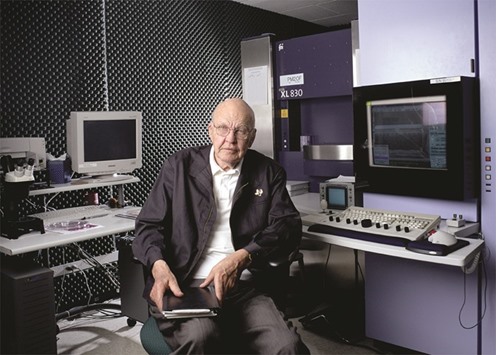Employees who don’t feel adequately appreciated by their bosses will certainly sympathise with story of US physicist Jack Kilby. The story goes back nearly 60 years when he invented something brilliant that his employer, Texas Instruments, barely would take notice of.
It was the summer of 1958, when his work colleagues were away on holidays, that he tinkered around with some equipment in the lab to construct an integrated circuit. It was the world’s first microchip.
But it would take almost ten more years before Kilby could illustrate the potential of the microchip – by making the prototype of the first pocket calculator. Kilby’s breakthrough idea was to combine transistors, resistors and condensers on a semi-circuit.
In 1958 he assembled the first-ever “integrated circuit” on a small glass plate using the chemical element germanium and patented the integrated circuit.
A year later, physicist Robert Noyce, working for the Fairchild company in California, also produced a microchip, using silizium for the circuit. His design triggered a patent dispute with Kilby, a wrangle that was resolved many years later in court.
Initially, Kilby had a hard time convincing his bosses at Dallas, Texas-based TI about his invention. They could see no concrete potential for the integrated circuits, and Kilby would later recall how they were regarded merely as a curiosity at experts’ congresses.
In 1966, he decided to come up with a practical application to prove the potential of his microchip, and together with his colleagues Jerry Merryman and James Van Tessel, constructed the world’s first pocket calculator. On March 29, 1967, Kilby presented the “Cal Tech” - which had nothing to do with the renowned technical university of the same name in California – to the director of Texas Instruments.
The instrument’s black aluminium case was almost as thick as a dictionary and weighed two and a half pounds – not exactly an item that would fit into a normal trouser pocket. But it ran on batteries and so was independent of electricity networks.
The “Cal Tech” could add, subtract, multiply and divide six-digit figures, but no more complex calculations. And so the TI bosses at first were only moderately impressed. It was the second time that Kilby had to endure his great invention being virtually ignored.
But the TI executives did make it possible for the Japanese firm Canon to start serial production of the “Cal Tech.” In April 1970, Canon introduced the “Pocketronic” in Japan in which the numbers likewise were not displayed electronically but rather printed out on small strips of thermal paper. The Pocketronic was introduced to the US market at the start of 1971, with a price tag of almost 400 dollars.
That same year, the Japanese manufacturer Busicom introduced the “Handy-LE” – the first LED (light emitting diodes) digits, and almost simultaneously in Japan, the Sanyo ICC-82D and the Sharp EL-8 calculators came onto the market. They cost around 500 dollars.
But prices would soon fall, and quickly. “In 1974 the first calculators for less than around 40 dollars arrived,” notes Andreas Stolte of the world’s largest computer museum, the Heinz Nixdorf MuseumsForum in the German city of Paderborn.
“The HP 35 of Hewlett Packard made possible the calculation of trigonometric and exponential functions. This first technical-scientific calculator appeared in 1972. That same year, Texas Instruments finally introduced a commercial application of its own invention with the TI-2500 Datamath.”
Even the triumphal march of the personal computer in the 1980s and 1990s could not slow down the boom in pocket calculators. For example, in Germany alone 4.4 million calculators were sold in 1999, according to the market research company GfK.
But now, with the dominance of the omnipresent smartphone, people are more and more leaving their calculators lying unused on their desks. After all, there are now countless pocket calculator Apps available for the iPhone as well as the Android phones.
With smartphones and tablets banned in most classrooms, students’ parents are having to choose a calculator from a catalogue listing those few that are admitted in the classroom – not to everyone’s absolute satisfaction.
“School calculators are not up to the latest technical standard and above all they are overpriced,” complains technology journalist Tim Gerber – an opinion that won him many backers.
Gerber says that for his daughter he has to spend over 100 dollars on the great-grandchild of the original “Cal Tech,” the “TI-84 plus CE” made by Texas Instruments.
As to Kilby’s uphill battle for recognition, the physicist would eventually receive the credit due him. In 1982 he was accepted into the Hall of Fame of American Inventors, an institution that included such people as Thomas Edison and the Wright Brothers.
In 2000, he received the Nobel Prize for Physics “for his part in the invention of the integrated circuit.” -DPA

It was 50 years ago, in 1967, that physicist Jack Kilby demonstrated his u201cCal Techu201d from Texas Instruments, the world’s first calculator.


